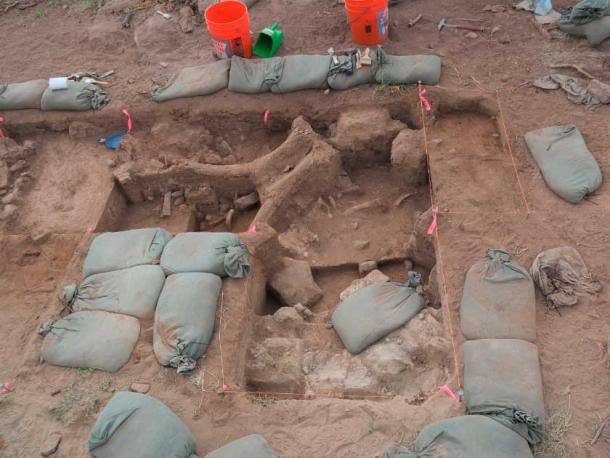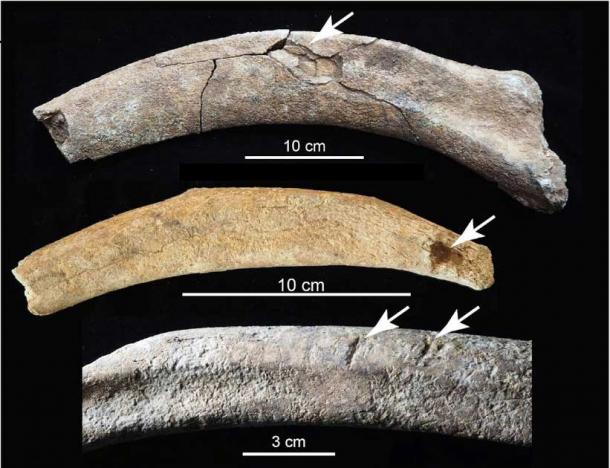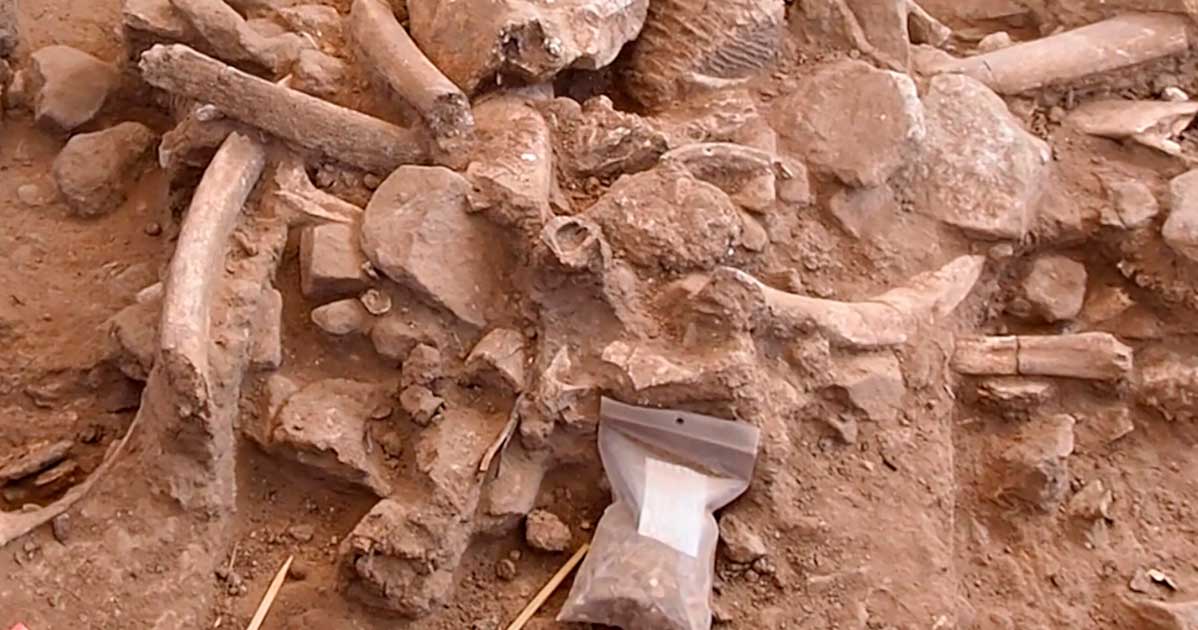New Mexico Mammoth Bones from 37,000 years ago “Upend” Clovis Theory
A team of scientists led by researchers from the University of Texas have uncovered compelling evidence to prove human beings settled in North America much earlier than had once been believed. That evidence comes from the excavated bones of a mother mammoth and her calf that were apparently killed and butchered by indigenous Americans living in the lands of modern-day New Mexico approximately 37,000 years ago.
Until now, archaeological excavations had produced no artifacts that would suggest human beings were living in this part of the world so long ago. In fact, the state of New Mexico has long been associated with the theory that the first settlers in North America were from the Clovis culture, which was created by people who arrived in the region no earlier than 16,000 years ago. A large cache of tools left behind by the Clovis culture were found near the eastern New Mexico city of Clovis, and that is why these ancient people were given a name that will forever connect them to the state.
But the latest discovery in New Mexico can be counted as yet another strike against the once-popular Clovis culture theory. In recent years many archaeologists and anthropologists have reported discoveries in North, South, and Central America that indicate humans were occupying the Americas long before the Clovis people are presumed to have arrived, and the unearthing of the 37,000-year-old butchered animal bones adds more data points to this growing body of evidence.
- The Great American Origins Debate: Clovis First vs Pre-Clovis
- Why Is This Mammoth Tusk In Deep Water Off the Californian Coast?

The excavation site where the New Mexico mammoth bones, mostly ribs and spine pieces, were discovered. The most prominent fossil is a portion of an adult mammoth skull. (Timothy Rowe / The University of Texas at Austin)
New Mexico Mammoth Bones Found On Professor’s Land
The researchers responsible for the discovery of the butchered mammoth bones and the revelation of their astonishing antiquity have just published the results of their analysis in Frontiers in Ecology and Evolution. Amazingly—and most unusually—the ancient mammoth bones were found in 2013 on the property of study lead author Dr. Timothy Rowe, a University of Texas paleontologist who owns land in New Mexico.
A neighbor of Rowe spotted the remains of a tusk sticking out of the ground on a hillside overlooking the professor’s home. When Rowe investigated, he found an extensive collection of broken and scattered mammoth bones, which were partially exposed and partially buried. He suspected right away that the bones were from an animal or animals that had been killed and butchered by humans, but there was no way to be sure without a much more extensive analysis.
Eventually a team of scientists (under Dr. Rowe’s leadership) was dispatched to the site to perform a more thorough excavation. What they uncovered was a one-of-a-kind bounty of evidence of ancient human activity.
Many of the fossilized New Mexico mammoth bones showed signs of blunt-force fractures, meaning they’d been broken into pieces intentionally. Other bones had been shaped into knives for use in butchering activities, and the wear and tear on these bone flake utensils made it clear that humans had been processing the mammoth remains to remove the meat and hides. Puncture wounds were found in vertebrae and rib bones, which means the humans who butchered the animals had drained them of their fat (it would have been used for cooking).
- Did Paleoamericans Reach South America First?
- Breaking News: Earliest Upper Paleolithic Humans in Europe Discovered!

Butchering marks on the New Mexico mammoth ribs. The top rib shows a fracture from blunt force impact; the middle rib shows a puncture wound, probably made by a tool; the bottom rib shows chopping marks. (Timothy Rowe et al. / The University of Texas at Austin)
“What we’ve got is amazing,” Rowe stated, in a University of Texas press release discussing the results of the scientists’ analysis. “It’s not a charismatic site with a beautiful skeleton laid out on its side. It’s all busted up. But that’s what the story is.”
The scientists extracted collagen from some of the bones, for the purposes of radiocarbon dating. These tests proved the mammoth mother and calf had lived somewhere between 36,250 and 38,900 years ago, putting them right in the middle of the Upper Paleolithic period. This extremely old date represents an enormous departure from traditional ideas about when the Americas might have been settled by the ancestors of the Native Americans.
Some of the evidence of human alteration of the bones was obvious to the naked eye. But a lot of the most revealing data was collected through CT scans taken at the University of Texas High-Resolution X-ray Computed Tomography Facility. These precise examinations revealed microscopic fracture networks in the bones that were fully consistent with toolmaking and butchering activities, and not explainable by any natural force.
“There really are only a couple efficient ways to skin a cat, so to speak,” Rowe explained. “The butchering patterns are quite characteristic.”
In addition to the mammoth bones, the researchers also found strong evidence showing that ancient inhabitants of the region had used controlled fires to shape their landscape. A chemical analysis of sediment from the site revealed the presence of fire particles that had come from a sustained and managed burn, and not from an out-of-control wildfire.
The Complex History of the Settling of the Americas
Anomalous finds in recent decades have put to rest the idea that the Americas were settled exclusively by the Clovis culture and had been unoccupied by humans until just 16,000 years ago. In addition to more ancient artifacts recovered by archaeologists, geneticists studying the genomes of indigenous peoples in South and Central America have found evidence to suggest that many are descended from an unknown people that lived in the region tens of thousands of years ago.
Based on such discoveries, many experts now propose that the Americas were settled by two founding populations, the Clovis people and another group that came before. The two groups remained apart for the most part, supporters of this thesis claim, creating two separate genetic lineages that have left their fingerprints in the DNA of modern indigenous peoples.
What can be said for certain is that the story of the settling of the Americas is more complex than what was once believed. The details of the complexity are only now beginning to come to light, as more and more indications of human activity in the distant past emerge from archaeological and scientific explorations.
Top image: A closeup of the 37,000-year-old New Mexico mammoth bones discovered during excavations at the site. This random mix of ribs, broken cranial bones, a molar, bone fragments, and stone cobbles is a refuse pile from mammoth butchering. Source: Timothy Rowe / The University of Texas at Austin.
By Nathan Falde


















Comments
There have been many civilizations going back for thousands and thousands (perhaps even millions) of years, all over the world. Nothing new here.
We know that the Hopi did not construct the stone houses and grottos they were living in. Like in many other regions, there was an earlier civilization that was supplanted.
Nobody gets paid to tell the truth.